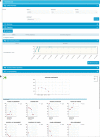A usability study in patients with stroke using MERLIN, a robotic system based on serious games for upper limb rehabilitation in the home setting
- PMID: 33622344
- PMCID: PMC7901008
- DOI: 10.1186/s12984-021-00837-z
A usability study in patients with stroke using MERLIN, a robotic system based on serious games for upper limb rehabilitation in the home setting
Abstract
Background: Neuroscience and neurotechnology are transforming stroke rehabilitation. Robotic devices, in addition to telerehabilitation, are increasingly being used to train the upper limbs after stroke, and their use at home allows us to extend institutional rehabilitation by increasing and prolonging therapy. The aim of this study is to assess the usability of the MERLIN robotic system based on serious games for upper limb rehabilitation in people with stroke in the home environment.
Methods: 9 participants with a stroke in three different stages of recovery (subacute, short-term chronic and long-term chronic) with impaired arm/hand function, were recruited to use the MERLIN system for 3 weeks: 1 week training at the Maimonides Biomedical Research Institute of Cordoba (IMIBIC), and 2 weeks at the patients' homes. To evaluate usability, the System Usability Scale (SUS), Adapted Intrinsic Motivation Inventory (IMI), Quebec User Evaluation of Satisfaction with assistive Technology (QUEST), and the ArmAssist Usability Assessment Questionnaire were used in the post-intervention. Clinical outcomes for upper limb motor function were assessed pre- and post-intervention.
Results: 9 patients participated in and completed the study. The usability assessment reported a high level of satisfaction: mean SUS score 71.94 % (SD = 16.38), mean QUEST scale 3.81 (SD = 0.38), and mean Adapted IMI score 6.12 (SD = 1.36). The results of the ArmAssist Questionnaire showed an average of 6 out of 7, which indicates that MERLIN is extremely intuitive, easy to learn and easy to use. Regarding clinical assessment, the Fugl-Meyer scores showed moderate improvements from pre- to post-intervention in the total score of motor function (p = 0.002). There were no significant changes in the Modified Ashworth scale outcomes (p = 0.169).
Conclusions: This usability study indicates that home-based rehabilitation for upper limbs with the MERLIN system is safe, useful, feasible and motivating. Telerehabilitation constitutes a major step forward in the use of intensive rehabilitation at home. Trial registration ClinicalTrials.gov, NCT04405609. Registered 06 January 2020-Retrospectively registered, https://clinicaltrials.gov/ct2/show/NCT04405609.
Keywords: Home training; Neurological rehabilitation; Robot; Serious games; Stroke; Telerehabilitation; Upper extremity.
Conflict of interest statement
The authors declare that they have no competing interests.
Figures






References
-
- Sivan M, Gallagher J, Makower S, Keeling D, Bhakta B, O’Connor RJ, et al. Home-based Computer Assisted Arm Rehabilitation (hCAAR) robotic device for upper limb exercise after stroke: results of a feasibility study in home setting. J Neuroeng Rehabil. 2014;11:16. doi: 10.1186/1743-0003-11-163. - DOI - PMC - PubMed
Publication types
MeSH terms
Associated data
LinkOut - more resources
Full Text Sources
Other Literature Sources
Medical

